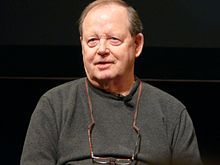Robert W. Taylor
Robert William Taylor (born February 10, 1932 in Dallas , Texas - † April 13, 2017 in Woodside , California ) was an American computer scientist . He was considered one of the driving forces behind the development of the Internet . Under his direction, the Arpanet was developed in the United States Department of Defense in the 1960s , which is regarded as the forerunner of today's Internet.
Life
Born in Dallas in 1932, Taylor traveled around Texas with his father, a Methodist minister. He later began studying psychology at the University of Texas at Austin , where he took minor subjects in mathematics, English and religious studies. After completing his studies, Taylor worked for various airlines , where he first came into contact with NASA . After he had submitted a research application to the aerospace authority, the latter offered him a permanent position in 1961.
Taylor was at NASA in Washington, DC during the Kennedy administration for the security of various scientific projects such as B. the Apollo program responsible for manned moon landings. In 1962, Taylor met the new head of a research department at the Advanced Research Project Agency (ARPA), JCR Licklider . Like Taylor, Licklider had written a diploma thesis on psychoacoustics and in 1960 published an article on new, modern ways of using computers.
He also met other visionaries like Douglas Engelbart at the Stanford Research Institute (SRI) in Menlo Park, California. Taylor was significantly involved in the financial support of Engelbart's targeted computer display technology project at the SRI, which aimed to develop the so-called "computer mouse". The first public demonstration of a “mouse” user interface later became known as “the mother of all demos”.
In 1968, at the Joint Computer Conference in San Francisco , Engelbart demonstrated to the SRI management team on a large screen how a computer that was at that time in Menlo Park could be operated remotely with the mouse he had developed.
In 1965, Taylor moved from NASA to ARPA, where he took the position of director. In 1970 he founded the Xerox PARC Computer Science Laboratories and worked as a manager. Taylor also worked for Digital Equipment Corporation and founded the DEC Systems Research Center (SRC) in Palo Alto. The SRC developed projects such as the Modula 3 programming language , the first multi-thread Unix system and the first user interface editor.
Awards
For his contribution to the development of the Xerox Alto , the first personal computer, he received several awards together with Alan Kay , Butler Lampson and Charles P. Thacker . In 1984 they received the ACM Software System Award and in 2004 the Charles Stark Draper Prize, which is endowed with $ 500,000 . In 2013 he became a Fellow of the Computer History Museum .
Web links
- Marion Softky: Building the Internet - a short biography. October 11, 2002, accessed June 6, 2010 .
Individual evidence
- ^ John Markoff: Robert Taylor, Innovator Who Shaped Modern Computing, Dies at 85. In: The New York Times . The New York Times Company, April 14, 2017, accessed April 15, 2017 .
- ^ John Markoff: An Internet Pioneer Ponders the Next Revolution. In: The New York Times . The New York Times Company, December 20, 1999, accessed June 5, 2010 .
- ^ Rüdiger Suchsland: The network. In: Heise Online . January 5, 2005, accessed June 5, 2010 .
- ↑ Gary sweet wines: Internet and use of the computer as communication device the 1960s brainchild of psychology alum. (No longer available online.) In: University of Texas at Austin . September 14, 2009, archived from the original on October 4, 2013 ; accessed on June 6, 2010 (English). Info: The archive link was inserted automatically and has not yet been checked. Please check the original and archive link according to the instructions and then remove this notice.
- ^ History interview with RW Taylor In: University of Minnesota. Published February 28, 1989, accessed February 3, 2013.
| personal data | |
|---|---|
| SURNAME | Taylor, Robert W. |
| ALTERNATIVE NAMES | Taylor, Robert William (full name); Taylor, Robert; Taylor, Bob |
| BRIEF DESCRIPTION | American computer scientist |
| DATE OF BIRTH | February 10, 1932 |
| PLACE OF BIRTH | Dallas , Texas , United States |
| DATE OF DEATH | April 13, 2017 |
| Place of death | Woodside , California , United States |
